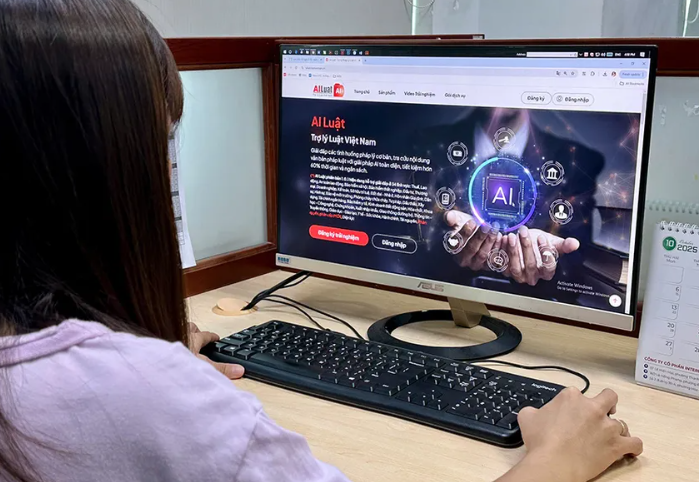AI and the Law: Building a Smarter Legal System for Vietnam
Associate Professor Võ Trí Hảo, from the Institute of International and Comparative Law (University of Economics and Law – VNU HCMC), argues that AI can transform the way law is written, stored, and operated, making the legal system more efficient, transparent, and cost-effective. To achieve this, however, Vietnam must modernize its legal framework and adopt standardized digital infrastructure.
The Promise of AI — and the Challenge of Vietnamese

AI holds enormous potential in law — more so than in many other sectors — because legal systems depend heavily on text and logic. In advanced jurisdictions like the U.S., U.K., Germany, and China, AI is already being used to analyze cases, predict rulings, and assist judges.
But in Vietnam, AI assistants for the legal field (AIA) still operate mostly at the level of simple legal lookups, lacking the ability to interpret complex legal contexts. This limitation stems largely from linguistic barriers:
-
Vietnamese is monosyllabic and tonal, like Chinese, but uses a Latin-based script, which complicates computational recognition.
-
It has no verb conjugation, few capitalization rules, and no grammatical gender or declension, making it difficult for AI to distinguish between subjects, verbs, and objects.
-
Words often change meaning depending on context — a feature that makes Vietnamese beautiful in poetry but challenging for legal AI models.
These linguistic traits make it difficult for even humans — lawyers, judges, and linguists — to interpret precisely. For AI, the task is even harder.
Key Reforms to Help AI “Understand” the Law
1. Modernize core legal codes.
Vietnam should revise major laws — the Civil Code, Penal Code, Civil and Criminal Procedure Codes — in line with UN standards, explicitly recognizing legal doctrine as a source of law, as stated in Article 38 of the Statute of the International Court of Justice.
2. Standardize legal publications.
All materials related to law — from statutes, dissertations, and academic journals to reports and government proposals — should follow uniform standards issued periodically by the Supreme People’s Court, similar to Incoterms or ISO guidelines.
3. Create a unified “legal operating system.”
Legal texts should be organized like an OS kernel, with clear numbering, references, and linkages — for example:
-
Constitution: No. 0
-
Civil Code: No. 0001
-
Penal Code: No. 0002
-
Civil Procedure Code: No. 0003
-
Criminal Procedure Code: No. 0004, and so on.
This structure would reduce legislative overlap and facilitate AI-based legal interpretation.
4. Establish a “Legal Vietnamese” language layer.
Vietnam needs a specialized variant of Vietnamese for legal drafting — more standardized, structured, and machine-readable. This would help AI systems process legal documents precisely, even before English becomes a widely used secondary legal language.
5. Strengthen constitutional referencing.
Every law should cite the specific constitutional provision it is based on. Decrees and circulars must clearly identify which laws or decrees they interpret, ensuring traceability and preventing “extra-legal” rulemaking. AI could then automatically map and detect inconsistencies across the legal hierarchy.
Digital Transformation of Legal Data
6. Add new metadata elements to every legal document:
-
Keyword table for searchability.
-
QR code for quick access.
-
Unique hash code issued by the National Data Center for document authenticity.
7. Replace the official gazette with a blockchain ledger.
All non-classified legal documents should be published and authenticated through a blockchain-based national gazette. This system would ensure transparency, traceability, and eliminate secret or backdated legal documents — a problem that has persisted for decades.
8. Centralize and monetize legal data for AI training.
Every publication in Vietnam should be required to submit a digital copy to the National Data Center, which would manage copyright payments and allow safe use of this data for AI model training — similar to a “data acquisition for public interest” mechanism.
AI for the Judiciary: From Theory to Practice
The People’s Court of Ho Chi Minh City Region 1 has begun developing a specialized AI system for judicial operations — marking a major step toward building a digital court.
This AI model, built on an open-source language foundation, is trained on internal legal data to analyze case files, interpret laws, and recommend legal reasoning with high precision.
Key features include:
-
Instant document analysis: AI reviews thousands of pages in seconds, minimizing oversight.
-
Automated summaries and indexing: Ensures consistent file organization.
-
Voice interaction: Judges can verbally command searches during hearings.
-
Sensitive data masking: Maintains privacy and confidentiality.
-
Legal basis suggestions: AI proposes potential legal grounds for rulings based on precedent and statute databases.
-
Mind map visualization: Displays relationships between parties, facts, and procedural steps for better comprehension.
While hardware limitations and old document formats still challenge performance, improvements in computing power and digitization will soon overcome these barriers.
Toward a Smarter, Transparent Legal Future
Vietnam’s journey toward an AI-integrated legal system requires more than just technology — it demands legal modernization, data transparency, and linguistic standardization.
As Associate Professor Võ Trí Hảo emphasizes, when law is written, stored, and operated like a unified operating system, AI will not only reduce costs and human error, but also strengthen national governance capacity in the digital era.
Ý kiến bạn đọc
Những tin mới hơn
Những tin cũ hơn
LUẬT SƯ NGUYỄN THỊ KIM OANH: NGƯỜI TRUYỀN LỬA TÍN – LAN TỎA NIỀM TIN
Là Chủ tịch kiêm Tổng Giám đốc Công ty CP Luật Nguyễn (Luật Nguyễn Corp) và người sáng lập Cộng đồng Doanh nhân Tâm Giao (TGEC), bà không chỉ là một luật sư tài năng mà còn là một nhà lãnh đạo, một người kết nối, và một tấm gương sáng về sự cống hiến và trách nhiệm. Với triết lý sống “Trao chữ tín...
-
 Bỏ thuế khoán: Đề xuất mới về kê khai thuế hộ kinh doanh
Bỏ thuế khoán: Đề xuất mới về kê khai thuế hộ kinh doanh
-
 Bộ Chính trị ra Chỉ thị tăng cường lãnh đạo giám định tư pháp, định giá tài sản
Bộ Chính trị ra Chỉ thị tăng cường lãnh đạo giám định tư pháp, định giá tài sản
-
 Lý do không áp dụng biểu thuế cho kỳ tính thuế năm 2025
Lý do không áp dụng biểu thuế cho kỳ tính thuế năm 2025
-
 Biểu thuế TNCN 5 bậc, thuế suất 35%: Đã tối ưu cho người lao động?
Biểu thuế TNCN 5 bậc, thuế suất 35%: Đã tối ưu cho người lao động?
-
 Ngành Thuế Ra Mắt Công Cụ Tự Kê Khai Trực Tuyến
Ngành Thuế Ra Mắt Công Cụ Tự Kê Khai Trực Tuyến
- Đang truy cập470
- Máy chủ tìm kiếm1
- Khách viếng thăm469
- Hôm nay98,986
- Tháng hiện tại628,174
- Tổng lượt truy cập4,697,239
-
 Khởi tố Đoàn Văn Sáng vì tội giết người ở Lạng Sơn
Khởi tố Đoàn Văn Sáng vì tội giết người ở Lạng Sơn
-
 Quỹ Phòng chống thiên tai đối với Doanh nghiệp.Bắt buộc hay Tự nguyện?
Quỹ Phòng chống thiên tai đối với Doanh nghiệp.Bắt buộc hay Tự nguyện?
-
 SJC gold price soars to nearly VND 133 million/tael, $900 premium over global market
SJC gold price soars to nearly VND 133 million/tael, $900 premium over global market
-
 Gold price gap between SJC and global market narrows by VND 6 million
Gold price gap between SJC and global market narrows by VND 6 million
-
 Foreigners Seeking a Vietnamese Driver’s License: What You Must Meet
Foreigners Seeking a Vietnamese Driver’s License: What You Must Meet








